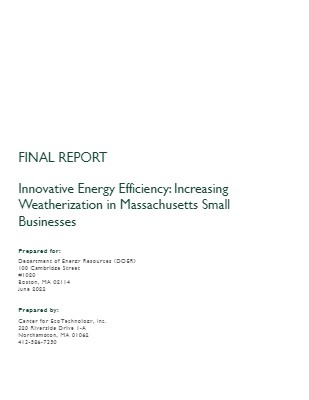Unlocking Energy Efficiency in Massachusetts.
From April 2020 to December 2021, CET worked with small businesses and utilities throughout Massachusetts to test new methods and approaches for accelerating the adoption of weatherization, other energy efficiencies, and strategic electrification measures among small businesses to drive cost-effective and comprehensive energy savings in the small business sector.
In all, the pilot program engaged 242 small businesses throughout the state, leading to annual savings of 964,316 pounds of carbon dioxide, 55,832 kWh of electricity, and 68,119 therms of natural gas. These improvements in energy efficiency yielded financial savings for customers as well, achieving $116,764 annually and $1,591,938 of savings for our customers.
In Massachusetts, small businesses represent 97 percent of commercial and industrial energy customers and 40 percent of energy use in the state, yet they are underserved by the Mass Save program. To address this problem, CET used an Innovate Energy Efficiency Grant from the Massachusetts Department of Energy Resources (DOER) to conduct a pilot program with small business customers.
5 key takeaways from the pilot that we learned about small business weatherization:
1. No-cost assessments and enhanced incentives
Many small business owners agreed to weatherization plans/ audits due to the no-cost assessments and enhanced incentives. Additionally, once educated on energy usage of natural gas systems, customers were more receptive to the program. The primary reasons owners declined were due to time and misconceptions or skepticism about the Mass Save program and audits.
2. Having a facilitator greatly increased the success rate
Of weatherization projects. This is critical for businesses that are too small for dedicated facility managers. CET facilitated saved time by connecting all the stakeholders, leading the sales process, and managing the project. This proved to be more beneficial than the Customer Directed option, which contractors indicated was more difficult to complete projects under.
3. The partnership between the weatherization contractors and CET was successful
in identifying customers through the mutual sharing of leads. This allowed CET to offer energy-saving, non-weatherization options to customers already scheduled with weatherization contractors directly, resulting in a seamless customer service experience.
4. For the pilot, CET created an energy savings modeling tool
to calculate energy savings, incentive levels, and project costs to provide small business owners with on-the-spot information to make efficient and informed decisions on next steps. Using the tool shortened the sales lifecycle, increased the number of projects, and was well-received by both customers and contractors.
5. With small businesses operating in older buildings
CET and weatherization contractors frequently identified roadblocks that halted or increased the costs of the weatherization project. To address the issue, some utility partners agreed to provide incentives for roadblock remediation (e.g., knob and tube remediation, venting, damming, intumescent paint for spray foam) on the condition that the project still passed the baseline benefit-cost ratio (BCR) test.
Innovative Energy Efficiency Report: Increasing weatherization in Massachusetts small business
Ashley Muspratt1 and Jon Blair2
1Center for EcoTechnology, 2Ipswich Electric Light Department

Need Free Assistance?
For more than 45 years, CET has helped communities, businesses & Institutions save energy and reduce waste.